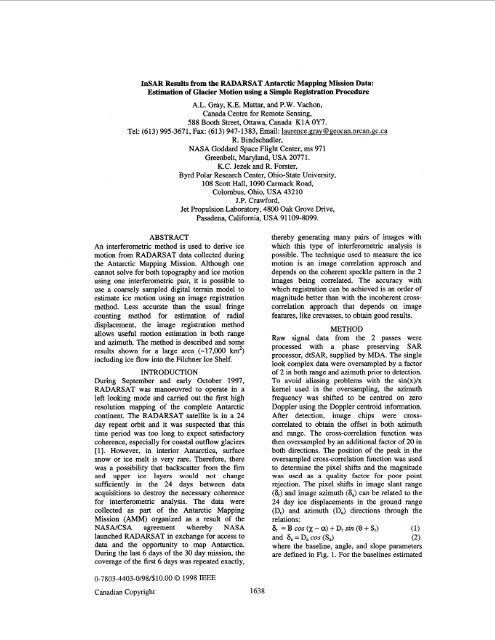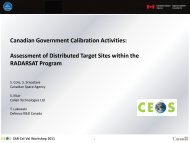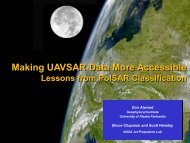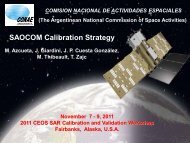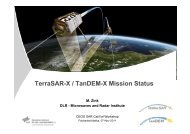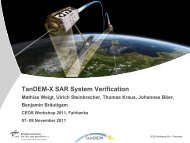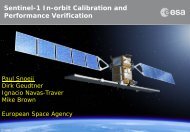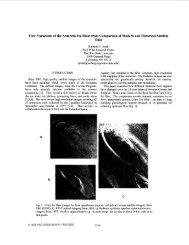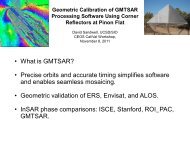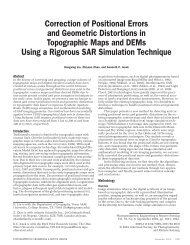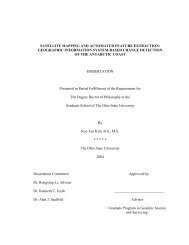Insar Results From The Radarsat Antarctic Mapping ... - IEEE Xplore
Insar Results From The Radarsat Antarctic Mapping ... - IEEE Xplore
Insar Results From The Radarsat Antarctic Mapping ... - IEEE Xplore
Create successful ePaper yourself
Turn your PDF publications into a flip-book with our unique Google optimized e-Paper software.
InSAR <strong>Results</strong> from the RADARSAT <strong>Antarctic</strong> <strong>Mapping</strong> Mission Data:<br />
Estimation of Glacier Motion using a Simple Registration Procedure<br />
A.L. Gray, K.E. Mattar, and P.W. Vachon,<br />
Canada Centre for Remote Sensing,<br />
588 Booth Street, Ottawa, Canada K1A OY7.<br />
Tel: (613) 995-3671, Fax: (613) 947-1383, Email: laurence.grav@p;eocan.nrcan.gc.ca<br />
R. Bindschadler,<br />
NASA Goddard Space Flight Center, ms 971<br />
Greenbelt, Maryland, USA 2077 1.<br />
K.C. Jezek and R. Forster,<br />
Byrd Polar Research Center, Ohio-State University,<br />
108 Scott Hall, 1090 Carmack Road,<br />
Colombus, Ohio, USA 43210<br />
J.P. Crawford,<br />
Jet Propulsion Laboratory, 4800 Oak Grove Drive,<br />
Pasadena, California, USA 91 109-8099.<br />
ABSTRACT<br />
An interferometric method is used to derive ice<br />
motion from RADARSAT data collected during<br />
the <strong>Antarctic</strong> <strong>Mapping</strong> Mission. Although one<br />
cannot solve for both topography and ice motion<br />
using one interferometric pair, it is possible to<br />
use a coarsely sampled digital terrain model to<br />
estimate ice motion using an image registration<br />
method. Less accurate than the usual fringe<br />
counting method for estimation of radial<br />
displacement, the image registration method<br />
allows useful motion estimation in both range<br />
and azimuth. <strong>The</strong> method is described and some<br />
results shown for a large area (-17,000 km2)<br />
including ice flow into the Filchner Ice Shelf.<br />
INTRODUCTION<br />
During September and early October 1997,<br />
RADARSAT was manoeuvred to operate in a<br />
left looking mode and carried out the first high<br />
resolution mapping of the complete <strong>Antarctic</strong><br />
continent. <strong>The</strong> RADARSAT satellite is in a 24<br />
day repeat orbit and it was suspected that this<br />
time period was too long to expect satisfactory<br />
coherence, especially for coastal outflow glaciers<br />
[l]. However, in interior <strong>Antarctic</strong>a, surface<br />
snow or ice melt is very rare. <strong>The</strong>refore, there<br />
was a possibility that backscatter from the fim<br />
and upper ice layers would not change<br />
sufficiently in the 24 days between data<br />
acquisitions to destroy the necessary coherence<br />
for interferometric analysis. <strong>The</strong> data were<br />
collected as part of the <strong>Antarctic</strong> <strong>Mapping</strong><br />
Mission (AMM) organized as a result of the<br />
NASAICSA agreement whereby NASA<br />
launched RADARSAT in exchange for access to<br />
data and the opportunity to map <strong>Antarctic</strong>a.<br />
During the last 6 days of the 30 day mission, the<br />
coverage of the first 6 days was repeated exactly,<br />
thereby generating many pairs of images with<br />
which this type of interferometric analysis is<br />
possible. <strong>The</strong> technique used to measure the ice<br />
motion is an image correlation approach and<br />
depends on the coherent speckle pattern in the 2<br />
images being correlated. <strong>The</strong> accuracy with<br />
which registration can be achieved is an order of<br />
magnitude better than with the incoherent crosscorrelation<br />
approach that depends on image<br />
features, like crevasses, to obtain good results.<br />
METHOD<br />
Raw signal data from the 2 passes were<br />
processed with a phase preserving SAR<br />
processor, dtSAR, supplied by MDA. <strong>The</strong> single<br />
look complex data were oversampled by a factor<br />
of 2 in both range and azimuth prior to detection.<br />
To avoid aliasing problems with the sin(x)/x<br />
kernel used in the oversampling, the azimuth<br />
frequency was shifted to be centred on zero<br />
Doppler using the Doppler centroid information.<br />
After detection, image chips were crosscorrelated<br />
to obtain the offset in both azimuth<br />
and range. <strong>The</strong> cross-correlation function was<br />
then oversampled by an additional factor of 20 in<br />
both directions. <strong>The</strong> position of the peak in the<br />
oversampled cross-correlation function was used<br />
to determine the pixel shifts and the magnitude<br />
was used as a quality factor for poor point<br />
rejection. <strong>The</strong> pixel shifts in image slant range<br />
(6) and image azimuth (6,) can be related to the<br />
24 day ice displacements in the ground range<br />
(Dr) and azimuth (D,) directions through the<br />
relations:<br />
S, = B cos (x- a) + Dr sin (0 + S,) (1)<br />
and 6, = D, cos (SJ<br />
(2)<br />
where the baseline, angle, and slope parameters<br />
are defined in Fig. 1. For the baselines estimated<br />
0-7803-4403-0/98/$10.000 1998 <strong>IEEE</strong><br />
Canadian Copyright 1638
for these data, typically less than 200 m, the error<br />
associated with the parallel ray approximation<br />
implicit in (1) is only a few centimetres, small in<br />
comparison with other errors. Knowledge of the<br />
baseline is required, as well as a digital terrain<br />
model for calculation of the incidence angle,<br />
look angle, and terrain slopes.<br />
I I I<br />
Ground<br />
9 9 I<br />
Fig. 1<br />
Illustration of the displacement geometry for<br />
calculation of the ground range displacement (Dr).<br />
B is the baselme, x is the baseline angle, cx is the<br />
radar look angle at the satellite, S, and S, are the<br />
terrain slopes in range and azimuth respectively (to<br />
the local horizontal), 8 is the local incidence angle,<br />
and &= S,+ 8,.<br />
In practice, it is normally possible to use 1 or 2<br />
points in the imagery, which correspond to<br />
exposed rock or mountains, to help calibrate the<br />
ice displacement information. Radar look and<br />
incidence angles are calculated for points in the<br />
digital terrain model by using the satellite orbit<br />
information and solving for the zero Doppler<br />
range between the point on the earth’s surface<br />
and the satellite track. <strong>The</strong> orbit data are used to<br />
get an initial estimate of the baseline B and the<br />
baseline angle x. <strong>The</strong> baseline information is<br />
refined using the zero velocity points.<br />
A complete error analysis is beyond the scope of<br />
this paper but the following points can be made.<br />
<strong>The</strong> pixel registration in areas of good coherence<br />
can be done to better than 1/10 of a pixel, the<br />
‘unit’ of pixel shift in this work is 1/40 of the<br />
pixel spacing. Small bias errors in velocity may<br />
exist when using an area that is assumed to be<br />
stationary. <strong>The</strong>se errors can increase with both<br />
baseline and the look angle difference between<br />
the reference area and the area for which the<br />
velocity estimate is being made. It is anticipated<br />
that errors in velocity will be in the range of 10<br />
cdday in range and around 3 cdday in<br />
azimuth. With poor digital elevation data, or<br />
poor baseline information, these errors will<br />
increase. Absence of a ‘zero velocity’ reference<br />
area will make the technique more difficult, and<br />
the results, more uncertain, however it is<br />
anticipated that velocity gradients will still be<br />
measurable.<br />
RESULTS<br />
Figure 2 illustrates the ice movement derived<br />
from two merged pairs of RADARSAT standard<br />
mode 2 images (100 km x 170 km) acquired on<br />
September 24 and October 18,1997. <strong>The</strong> vectors<br />
represent the ice motion of the Slessor Glacier as<br />
it flows into the Filchner Ice Shelf in Western<br />
<strong>Antarctic</strong>a. <strong>The</strong> vector direction corresponds<br />
well with the flow lines in the glacier and, as the<br />
range and azimuth displacement estimates are<br />
independent, the agreement between the derived<br />
directions and the ice stream flow lines helps<br />
validate the derived velocities. <strong>The</strong> acceleration<br />
in the ice stream as it enters the floating ice shelf<br />
is apparent. Velocities in the more southerly<br />
(upper) part of the glacier change from around<br />
250 dyear as the ice enters the area covered by<br />
the image to almost 800 dyear as it leaves at the<br />
bottom right-hand corner.<br />
CONCLUSIONS<br />
In 24 days time ice displacement can be large<br />
enough that a simple image registration<br />
technique can lead to useful results for ice<br />
motion. <strong>The</strong> advantages are:<br />
Displacements in both range and azimuth<br />
can be measured.<br />
Phase analysis is not essential, so that errors<br />
due to phase aliasing or incorrect phase<br />
unwrapping are avoided.<br />
0<br />
Local errors do not propagate through the<br />
image as they can with phase analysis.<br />
In some cases, use of the phase information<br />
could be used to improve the range velocity<br />
or velocity gradient estimation.<br />
<strong>The</strong> accuracy requirements for orbit and<br />
terrain topographic data are not as stringent<br />
as for conventional interferometric analysis<br />
for terrain motion.<br />
ACKNOWLEDGMENTS<br />
Dirk Geudtner (DLR) provided help and<br />
software for our early work on RADARSAT<br />
1639
interferometry. <strong>The</strong> Canadian Space Agency,<br />
REFERENCE<br />
CSA, and RADARSAT International, RSI, also 1. Goldstein, R.M., H. Englehardt, B. Lamb,<br />
helped in making data available to CCRS in and R.M. Frolich, Satellite radar<br />
order to do an initial evaluation of the potential<br />
interferometry for monitoring ice sheet<br />
of interferometry.<br />
motion: Application to an <strong>Antarctic</strong> ice<br />
stream, Science, 262, 1525-1530, 1993.<br />
Figure 2<br />
Illustration of ice motion from the Slessor Glacier (upper left) as the ice enters the Filchner Ice Shelf and<br />
flows as an ice stream northward towards the shelf edge. Two mosaicked pairs of RADARSAT standard<br />
mode 2 images were used to create this image (100 km x 170 km) of ice motion. Velocities in the more<br />
southerly (upper) part of the glacier change from around 250 dyear as the ice enters the area covered by<br />
the image to almost 800 &year as it leaves at the bottom right-hand comer.<br />
1640


